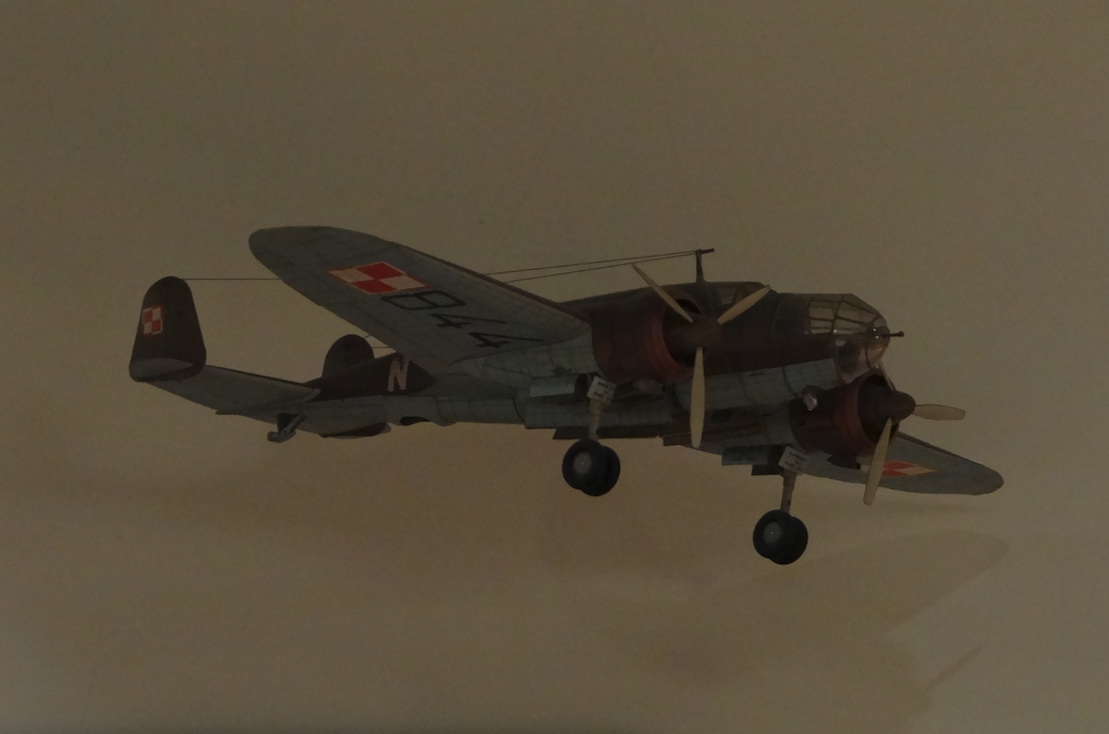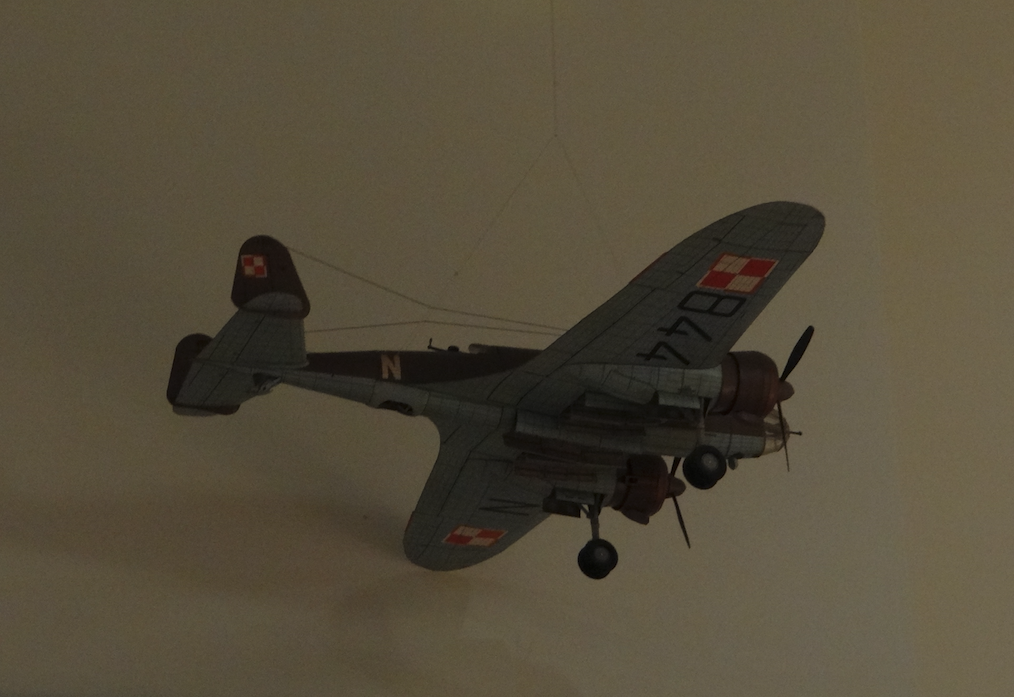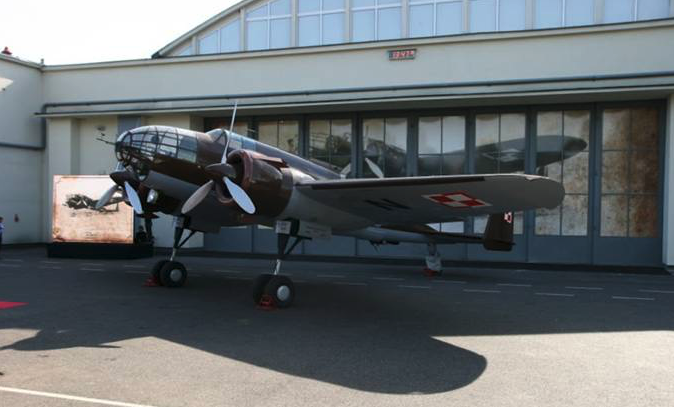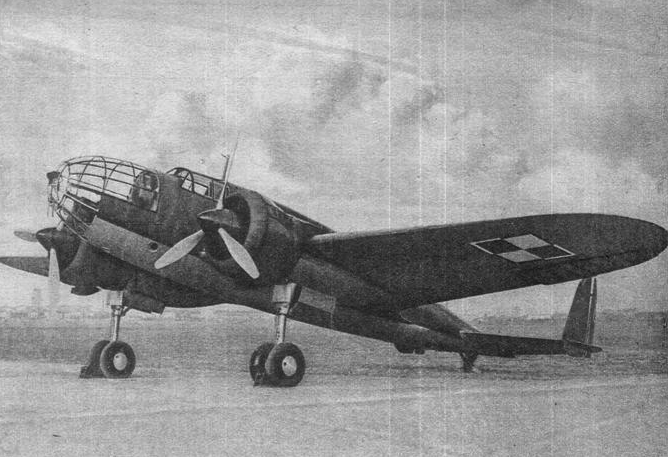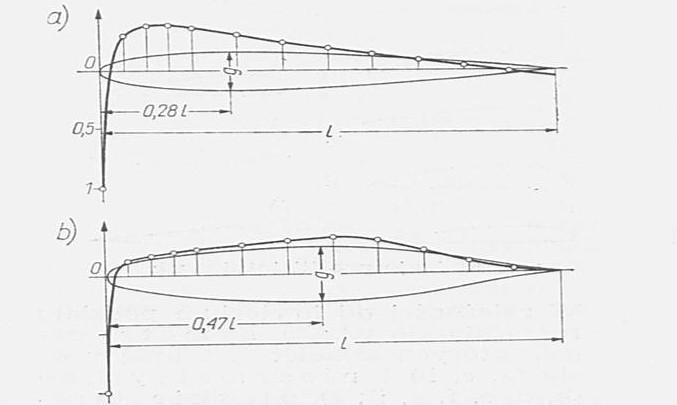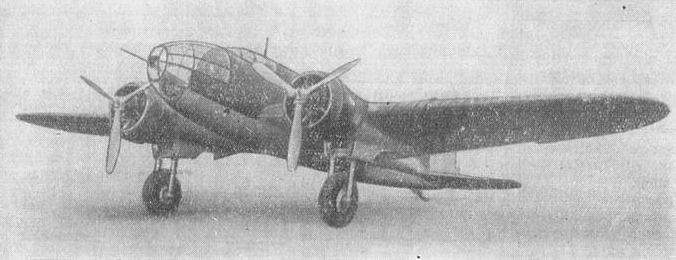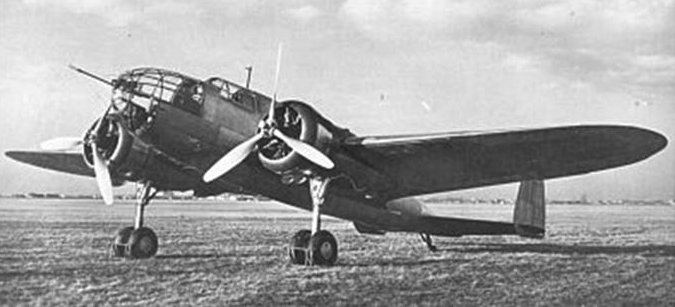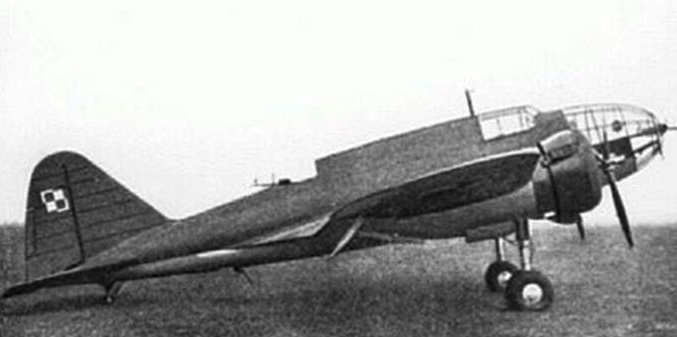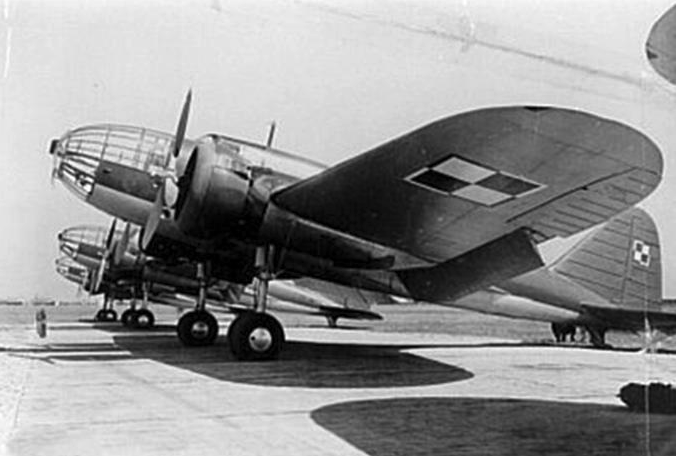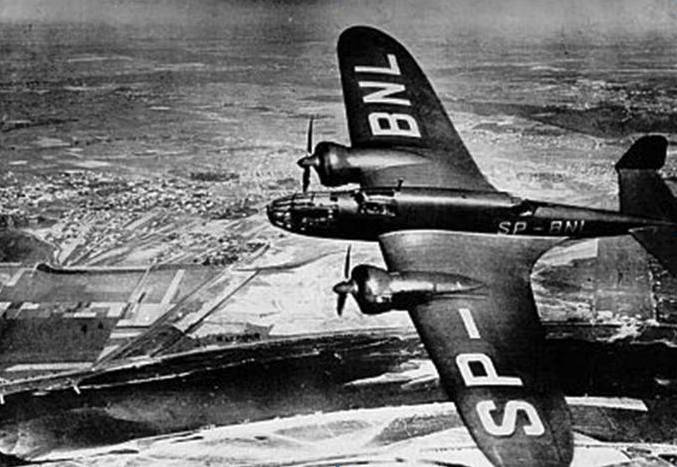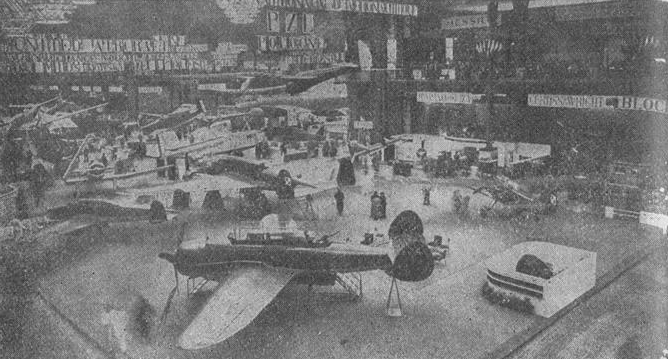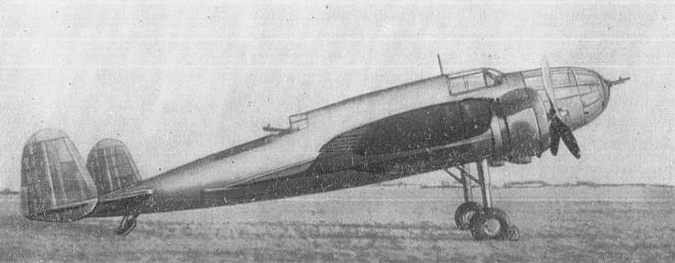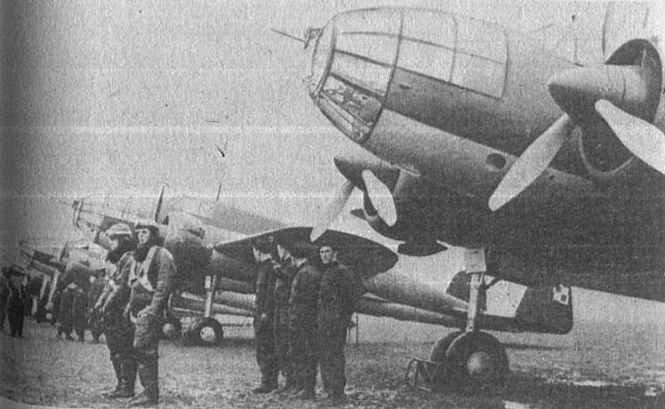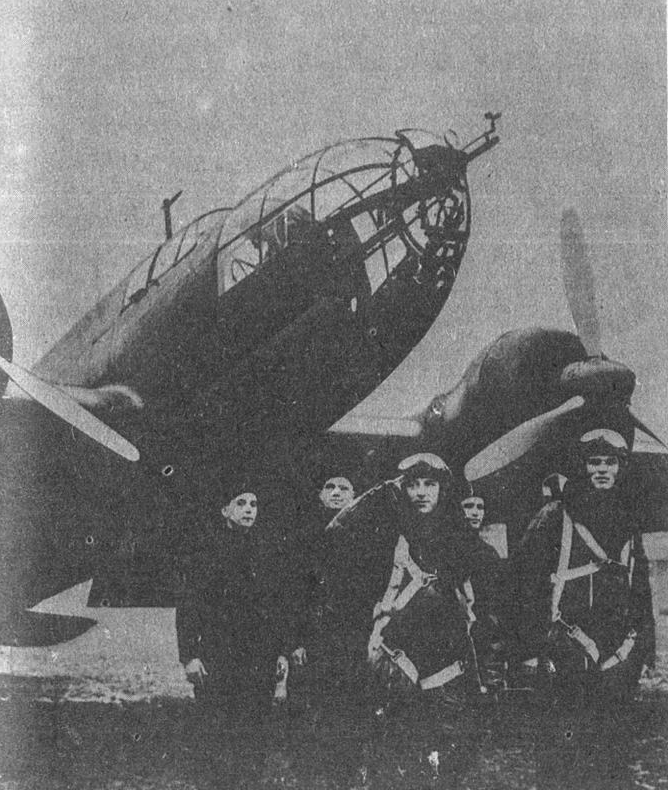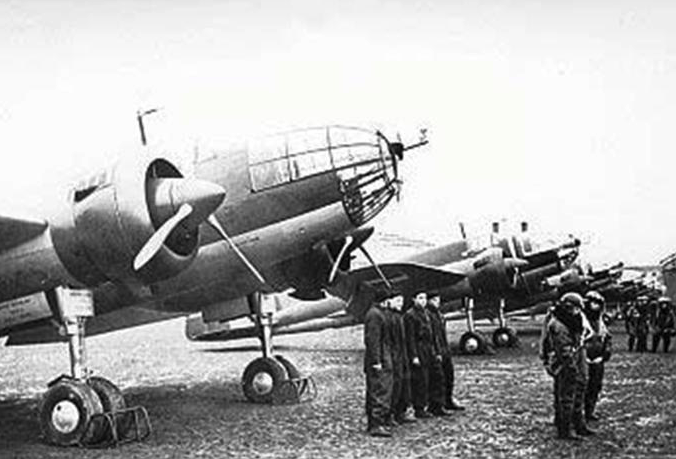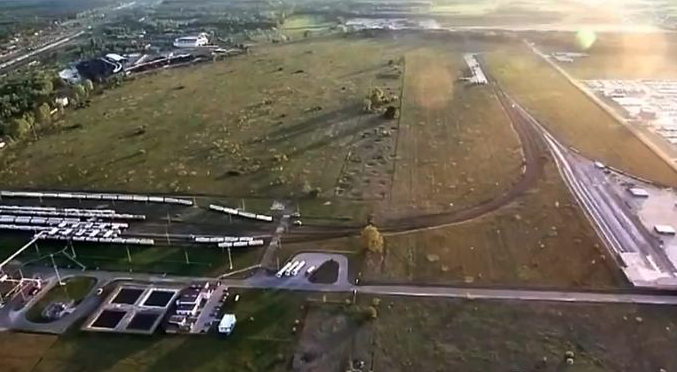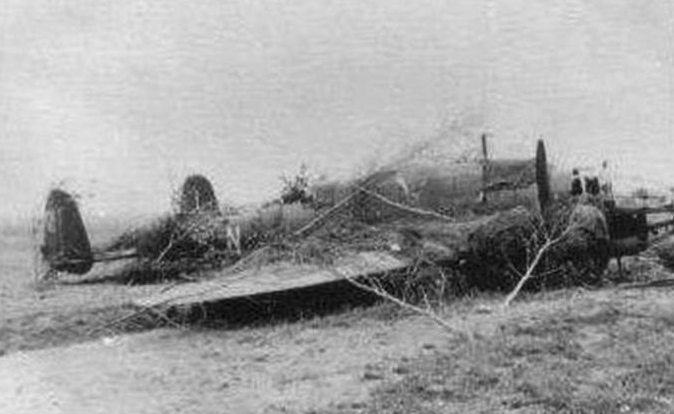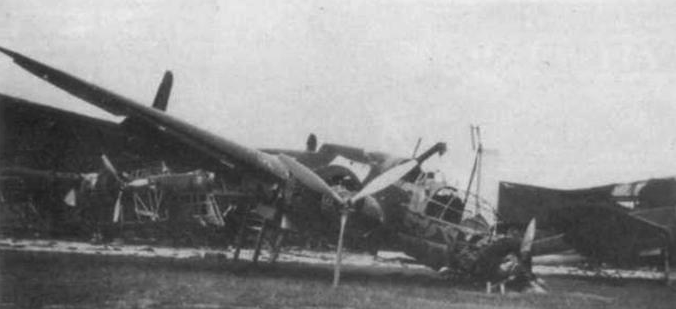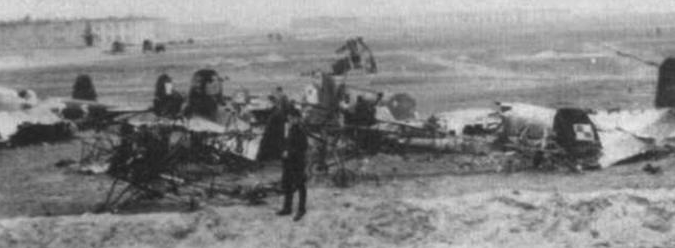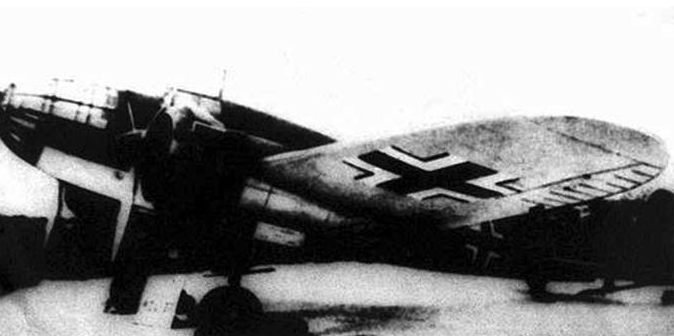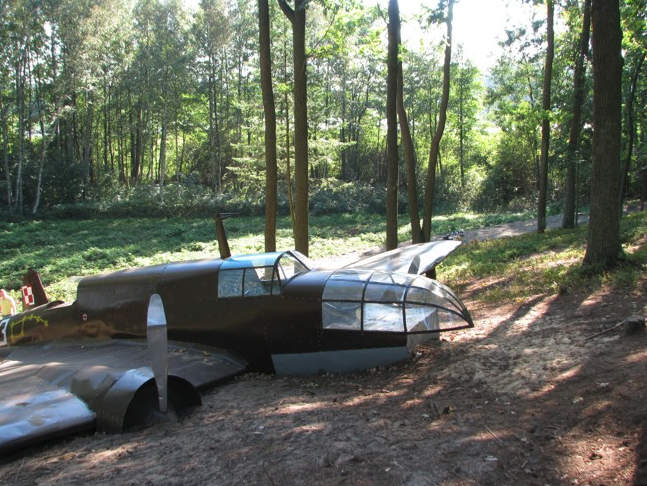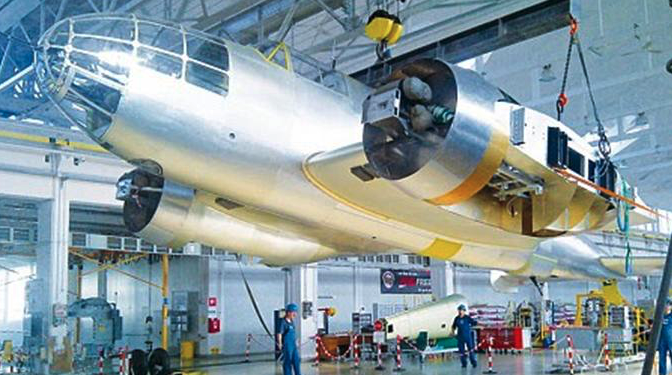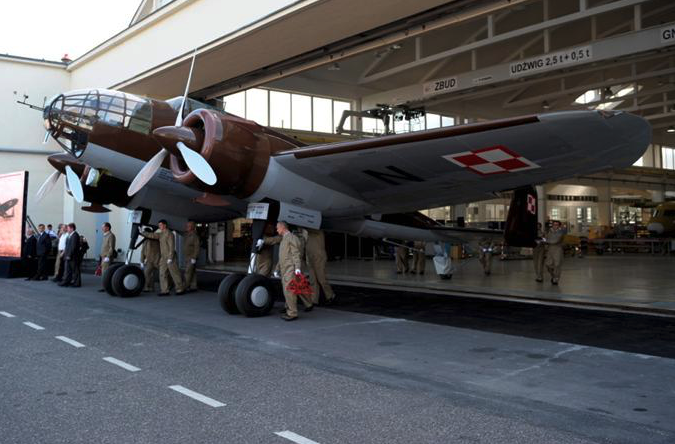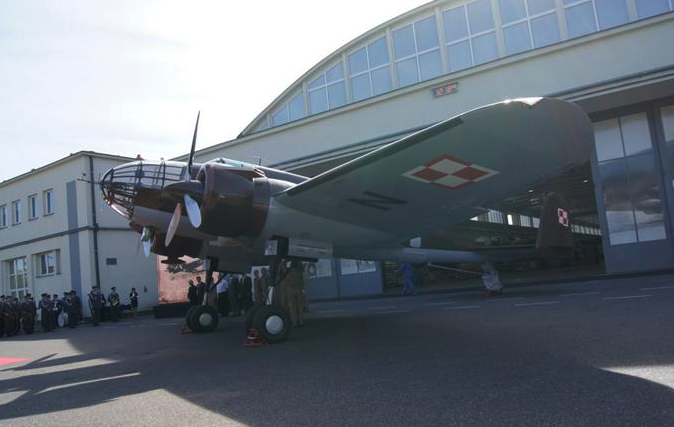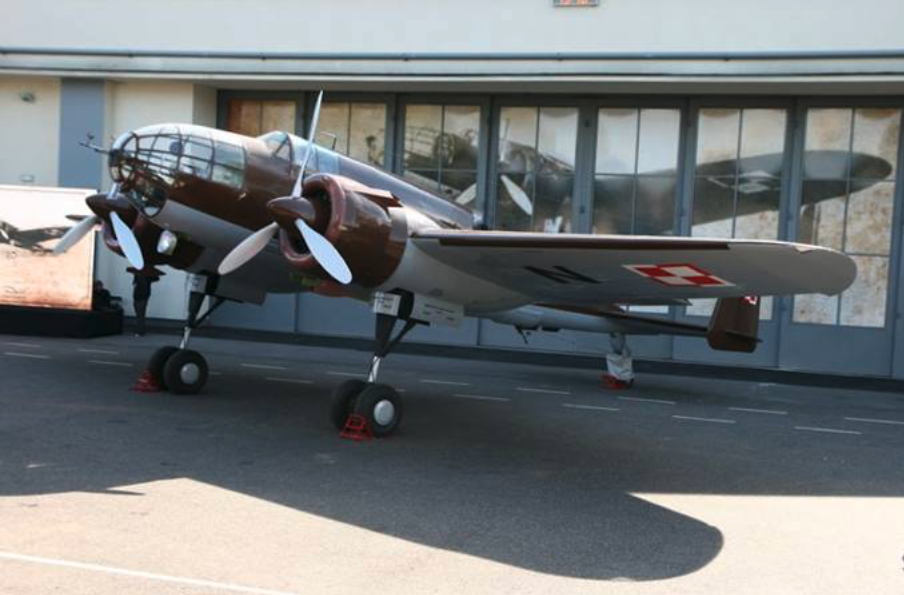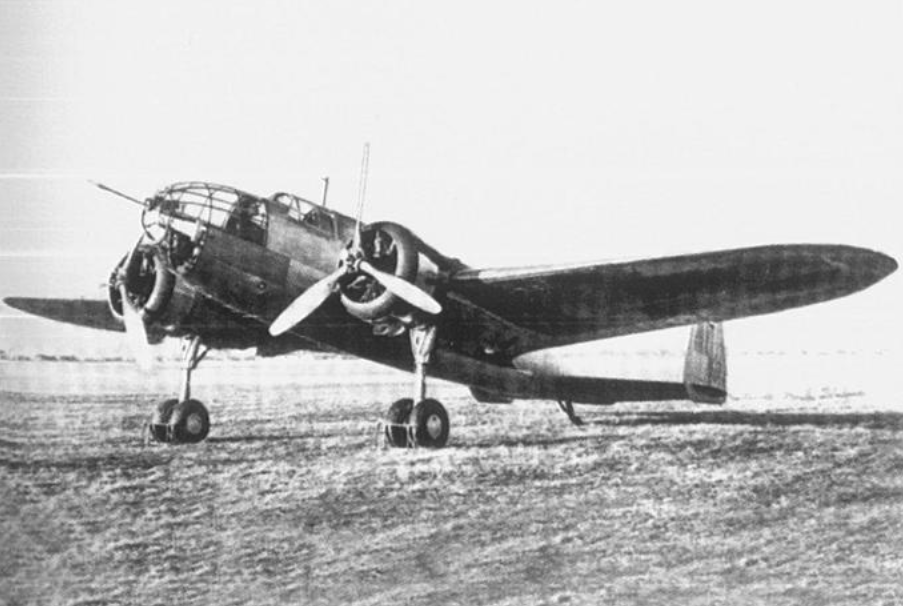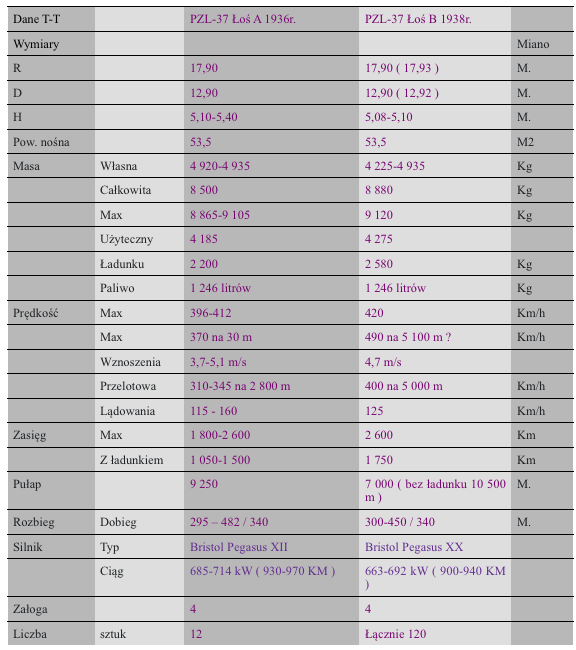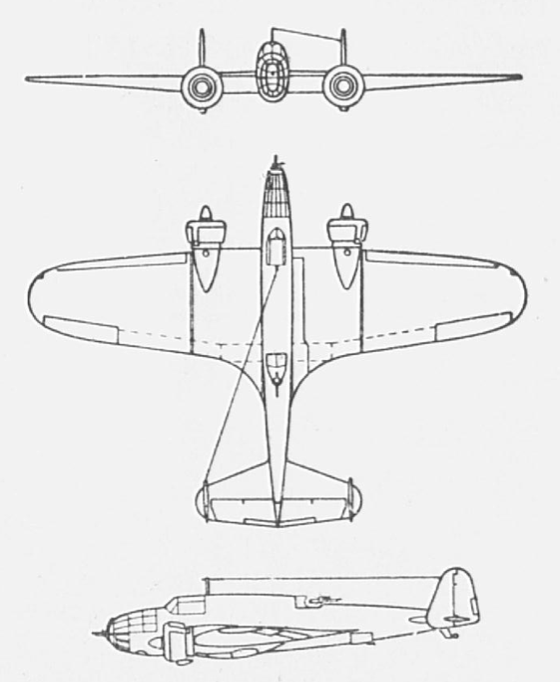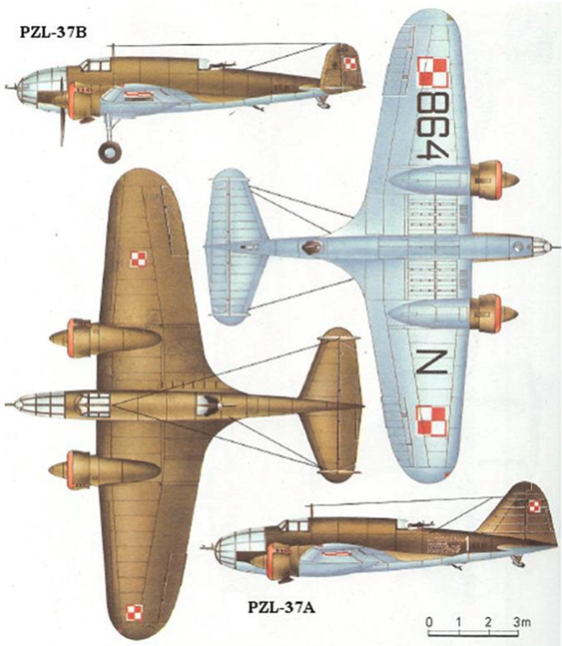Kraków 2012-11-01
Section 1936-12-13
PZL PZL-37 Łoś
Poland
Bomber.
History
In the history of Polish Aviation there were several fantastic constructions that aroused huge interest abroad. The design solutions used in them have often set standards. Currently (2012) it is hard to believe. One of such planes was PZL-37 Łoś.
PZL-37 Łoś is a perfect example of the ability of Polish constructors and design offices to create modern and innovative structures. Surprising ease of piloting. Simplicity of technical service. Resistance to extreme situations. Unfortunately, the attack of the German plague (September 1, 1939) meant that PZL-37 Łoś shared the fate of many Polish constructions, prematurely ending a promising career.
Why was the design of the PZL-37 Łoś aircraft undertaken?
At the beginning of the 1930s, Polish Bomb Aviation was based mainly on outdated Fokker F.VII 3m constructions, produced under a Dutch license. They were originally passenger planes, adapted only for bomb operations. The design of a typical bomber was dramatically missing. An aircraft designed and constructed in Poland, and at the same time modern. Against this background, PZL-37 Łoś was created.
It should also be remembered that PZL-37 Łoś was not the only project for a medium bomber. Competitive projects for Łoś were; LWS-6 Żubr and Lublin R-XXB. The purchase of a license for the Lockheed L-10A Electra aircraft was also seriously considered for adaptation to the bomb version.
Several preliminary projects were submitted to the PZL Construction Council. The council of the presented projects gave a positive opinion on the project of engineer Jerzy Dąbrowski and commissioned him further work (preliminary dimensional design and mock-ups on a natural scale).
Concept and design PZL-37 Łoś
The concept of the aircraft was developed by the Department of Aeronautics. It was this body that issued the initial Tactical and Technical Guidelines. Engineer Jerzy Dąbrowski became the lead designer. His deputy and right hand was engineer Piotr Kubicki. Franciszek Misztal became the panel builder.
He started working on the plane in the autumn of 1934. This project was designated P-37/34. For constructors, insight into foreign achievements was not without significance, including designs developed in the USA and reaching speeds of over 350 km / h with the twin-engine propulsion system.
The basis was the development of a medium-sized bomber aircraft, matching the speed of fighter aircraft. The basis were engines that could be used. An important factor was also the largest possible lifting capacity, ensuring effective transfer of bomb load.
Engineer Jerzy Dąbrowski in his design used a wing with flaps that increase lift force during take-off and landing. A retractable undercarriage was used. The engines have received compressors that increase power at higher levels. Propellers have received a variable bevel. The fuselage itself received a shape similar to the wing profile, thanks to which it not only placed less aerodynamic resistance, but also participated in the production of lift (it can be up to 15%). The construction of a self-supporting medium wing, all-metal, with careful aerodynamic shape and functional planning of the hull distribution was assumed. A modern half-shell construction has been used.
The bomber was supposed to reach a speed of 400 km / h, i.e. it was to be faster than all fighters at the time. The range was to be 3,000 km. Bombs capacity 2,000 – 2,500 kg. As defensive armament, two machine guns were foreseen at the front and one 20 mm cannon on the back.
Laminar profile
Engineer Jerzy Dąbrowski used a laminar flow profile wing in his design. Such a profile creates less aerodynamic drag than a classic flow profile. The laminar wing profile was partly due to chance. The plane was supposed to have bomb chambers not only in the fuselage but also in the wings. It allowed the construction of a retractable chassis that was located behind the engines. The bomb chambers in the wings were supposed to contain standard used 110 kg weight bombs. Engineer Franciszek Misztal started from the wing profile marked JD12. However, it soon turned out that with the selected contour and dimensions of the wings, the bombs would not fit in them. Therefore, the designer increased its relative thickness from 12% to 14% and shifted the maximum thickness from about 30% to more than 40% of the chord. Tests in the tunnel of the Aerodynamic Institute showed a significant reduction in the drag coefficient Cx at its constant value in the range of the angle of attack from -4 to 5 degrees, while with classic profiles the minimum value of Cx only referred to the most favorable angle of attack. This fact surprised everyone. This means that despite the lower lifting force of such a profile, it maintains this force on a larger scale of attack angles. Perfect for high-speed combat aircraft. This profile became popular among Polish aviation constructions and was used e.g. in Jastrzębie, Sumie, Wilko and Misie.
Further decisions and work
In October 1934. PZL (Państwowe Zakłady Lotnicze) received permission to build a prototype, with a recommendation to develop further. So financing. An information series of 10 were ordered immediately. The production of these 11 machines was to be started in the newly built PZL – WP-1 plant at Paluch, near the Okęcie airport. The new factory was ready in the autumn of 1934. The PZL factory moved there at the turn of 1934-1935.
In December 1934, permission was granted to make a life-size hull model. The model was approved in April 1935, after which the order for the prototype (for endurance tests) and the option to buy 10 pieces was confirmed. At the same time, the Aviation Technical Institute proceeded to develop a full technical specification of the type based on the guidelines of the Aeronautics Department, including the details of armament, combat equipment and auxiliary equipment.
Due to the anticipated high speed of the aircraft, it was recommended to limit the equipment to single km at all positions. With such equipment, the PZL-37 was to develop a speed of about 400 km / h, i.e. higher than the P.11c fighter equipped. It should be mentioned that at that time two views clashed on the defense of bombers. Either use high firepower against attacking fighters, or avoid fighting with the advantage of speed. It should be remembered that each additional machine gun and ammunition for it are additional kilograms.
The aircraft was armed with three movable machine guns wz. 37.79 mm or Vickers F 7.69 mm rifles operated by crew members. The aircraft was able to carry up to 2,242 kg of bombs in the chambers, in the fuselage and wing, which was the result at that time unrivaled.
PZL 37 / I Łoś – the first prototype.
The construction of the aircraft began at the PZL Prototype Department in the autumn of 1935. The aircraft with serial number 0001 was to be used for static tests, but it is very likely that this number has already received the model. The fact is that due to a lack of sufficient funds, the number of ordered prototypes has changed.
The aircraft serial number 0002 was a volatile prototype. It was also given the name Łoś and the military number was "72". The copy uses a mechanical system for retracting the undercarriage and extending the flaps. To retract or extend the undercarriage, the radio operator made 200 crank turns. Ultimately it was a hydraulic system.
In January 1936, in the prototype under construction, structural errors were detected in the control system and in the chassis, which slowed down the work. Another problem turned out to be the deformation of the plating. The reason was too rarely riveted cabin floor, made of sheet metal 2.5 mm thick, which was also a force element. The defects were removed in two months and in April 1936. aircraft no. 0002 was ready.
In the spring of 1936, various tests were carried out at the Institute of Aeronautical Research. As a result, there were reservations about starting and controlling the engines and strengthening the internal structure of the wings (girder belts). That is why aircraft No. 0002 was returned to the hall. The defects were corrected until the end of May 1936. (Other sources state the end of September 1936).
It is worth mentioning that during the construction of the first flying prototype, over 600 corrections were made to the original design, which is completely normal. Let’s remember that it was a highly innovative design.
The first volatile prototype PZL-37 / I No. 0002 was completed in May 1936. He was ready to fly in September 1936.
The first flight of prototype No. 0002 is scheduled for October 22, 1936. However, one of the Bristol X engines refused to work that day. It turned out that a metal pin was thrown in through the spark plug hole. The case could not be clarified; whether it was sabotage or accident. Problems with the engines repeated again.
Even before the first flight, in December 1936, Bristol Pegasus X engines were replaced with newer Bristol Pegasus XII.
There is information in the literature that the first flight was made as early as June 1936, which is possible but unlikely. It is possible because the plane began to be assembled from autumn 1935 and Bristol Pegasus X engines were already available. However, it should be assumed that the date given was the first flight plan and was already disseminated for advertising purposes.
Makes him stand out; main chassis with single wheels on double legs, single vertical tail, no hubcaps on propellers. The plane has a probe in the glazed bow. 1936 year.
First flights
The first flight was made on December 13, 1936. The pilot was Jerzy Widawski. Flight course without much attention, although slight vibration of the tail was observed. The chassis was not retracted during the flight.
In subsequent flights, the vibrations repeated. As a result, the engine bed frame cracked. The exhaust pipes of both engines have also broken. Engine reducers were damaged. The problem was also the insufficient cooling of the engines, which, due to the winter season, was even worse for the summer.
The prototype had a single tail in the caudal part. It was powered by 9-cylinder Bristol Pegasus XII B engines with 2 x 873 hp each. Three-blade propellers, metal. The aircraft had a strength structure with a safety factor of 3, which allowed the use of 2 engines with power from 2 x 800 HP to 2 x 1 200 HP.
Main landing gear of the aircraftThe prototype was made with a main chassis with single wheels on doubled legs. However, when landing on unadjacent terrain, it turned out that the landing gear is hard and the plane does not tolerate all unevenness badly. That is why the chassis has been redesigned. The new chassis was developed by engineer Piotr Kubicki. For the first time in the world, an independent twin wheel suspension system was used. This meant that they could work independently in uneven terrain. Each wheel was evaded individually. It allowed not only for typical operation from field airports, but for safe landing even on a potato field. The chassis turned out to be sensational and was patented by PZL.
Polish Patent No. 29090.
Further work
The overall assessment of the aircraft was positive. It was found that the aircraft would meet the recipient’s expectations after making improvements. The Air Force Command changed the order from 10 to 30 machines with delivery by the end of 1938. Under this order, 29 units were to be picked up by the Polish Army, and one aircraft, in the form of a second prototype, was to be used to try a double tail to improve the firing field in the rear hemisphere, which the army sought. It was also assessed that the doubled vertical tail would completely eliminate the hull back vibrations.
With the advent of spring 1937, more research and development topics began. Armament tests and a series of test flights were carried out at the Aviation Technical Institute. A speed of 420 km / h was then achieved. Tests ended in a 200-hour rush.
In August 1937, the plane was again in PZL for several modifications. The prototype changed in this way was sent to the ITL Independent Experimental Squadron for another 200 hours of operational tests.
PZL-37/II Łoś
PZL-37 / II Łoś – the second prototype, at the same time the second volatile machine. The machine carried number 0003. It had military number 72.2. Installation began before the flight of the first prototype, also at the Prototype Department. The plane was to be the benchmark for serial construction. Changes and modernizations resulting from the tests of machine No. 0002 were introduced on a regular basis. The first flight was probably made in November 1937.
In terms of design, the machine differed from the first prototype by a double tailgate and a different chassis (mentioned above).
The plane was powered by Bristol Pegasus XX engines with 2 x 918 hp. The aircraft had a reconstructed crew space, Meisser’s hydraulic installations. Additionally, in the observer’s cabin it was possible to install a disassembled tiller, and the lower shooting position was equipped with a manually sliding cover covering the fuselage pattern.
Preparation for serial production
After conducting ground and flight tests, the Military Adjudicating Committee issued a permit to commence mass production of the PZL-37 Łoś aircraft. The flight of the model specimen was slightly delayed and took place in November 1937 at Okęcie, shortly after the departure of prototype No. 0003.
It turned out that at low speeds and landing, the rear of the plane falls into unpleasant flutter vibrations. This defect was removed by riveting dural overlays increasing the rigidity of the horizontal stabilizer girders.
Test results confirmed compliance with the requirements and gave a good assessment of the aircraft. At the end of the year, the prototype was transferred to the Prototype Squadron of the ITL Independent Experimental Squadron.
Two engines are provided as propulsion for the aircraft; 9-cylinder, star-shaped, air-cooled, with power from 2 x 837 hp in version A to 2 x 1 050 hp in a single D series.
PZL 37 A Łoś (Łoś I)
PZL 37 A Łoś (Łoś I) – the first serial version of Łoś. In August 1937, a series of 30 PZL-37 aircraft was ordered with delivery starting in January 1938. Initially, the model for this series was to be aircraft No. 0003, prototype P-37 / I, which after changes took on the features and name of the P-37 / II prototype. The army wanted the PZL-37 / II version. Because PZL was ready to start production, but version P-37 / I, the Air Force Command agreed that there were 10 version A aircraft based on the first prototype in the batch ordered, i.e. with a single tail, but with a new chassis. Their construction was simply far advanced. The plane had Bristol Pegasus XII B engines with 2 x 873 hp. 10 aircraft of this version carried military numbers from 72.3 to 72.12.
Manufacturer-user rifts were also about engines. The second prototype of the PZL-37 / II aircraft was already flying with Bristol Pegasus XX engines. But the final first copies had Bristol Pegasus XII engines.
The production of aircraft began in the autumn of 1937 in PZL-Okęcie. These planes were completed at the beginning of 1938, originally they did not have hubcaps, and with the exception of one copy, they remained unarmed until the end of the year. They were never equipped with automatic bombing machines, and therefore had the possibility of only mechanical dropping of the entire bomb load.
PZL-37 A. A clearly visible chassis with double wheels and a single vertical tail.
A disaster
On June 20, 1938, a disaster occurred during tests conducted by the Institute of Aviation. During the task – a flight for a higher pilotage, i.e. aerobatics, the plane’s wing crumbled in a loop. The machine fell to the ground near Piaseczno, burying the crew in its remains. The pilot in this flight was a platoon pilot Stanisław Macka. The plane wreck was transported to Mokotów Airport. The investigation showed that the cause of the accident was faulty riveting, caused by imprecision of corrugated Junkers. This caused the necessity of riveting 20 ready sets of wings to check the quality of their riveting. Later, the wreck was used by cadets from the Aviation Cadet School (technical group) at Mokotów Airport as a teaching aid.
PZL 37 A bis Łoś (Łoś I bis)
PZL 37 A bis Łoś (Łoś I bis) – these were the remaining 20 machines of version A. These were already based on the P-37 / II prototype. They had a double tail. From the A series, 17 machines had Bristol Pegasus XII B engines. The rest received Pegasus XX engines.
The first two copies with military numbers 72.13 and 72.14 received civil registration, respectively, SP-BNK and SP-BNL. They served as demonstration copies. SP-BNL received Pegasus XX engines and officially the designation Moose A bis on the tail. The first flight was made in early May 1938. and sent to the international air exhibition to Belgrade. The exhibition took place on May 28, 1938. – 13.06.1938 .. The plane aroused great interest there.
In December 1938, this aircraft was shown at the 16th Paris Air Show, where it was also successful. Colonel pilot Charles Lindberg, the first to cross the Atlantic in 1927, admired him and spoke positively.
XVI Aviation Salon in Paris in 1938. View of the Polish stand PZL. They stand on it; Moose, Wolf, Pointer, Catfish, Seagull. Above, a large inscription: PZL POLOGNE.25.11.-11.12.1938 year.
After introducing several changes on the SP-BNL, and a successful international presentation, the aircraft became a model for the serial production of PZL P-37 B.
PZL 37/III Łoś
PZL 37 / III Łoś – the third prototype. It was Łoś A bis, which was given civil registration SP-BNK. Although the construction of serial machines was to be started, in 1937. – 1938, numerous tests were carried out on it. According to the sources, it was the A bis version adapted for tests. This specimen was tested in flight, among others, with Gnôme-Rhône 14N00 / 01 engines (2 x 751 kW and 2 x 1 020 HP) and was to serve as a model for the export version of the P-37 C bomber. 453 km / h at an altitude of 4,250 m. This prototype was intended to be used for a series of tests with various star engines: Renault 14T, Gnőme-Rhőne 14N, and Fiat A-80 RC41, whose 3 copies, the Fiat company provided PZL with offer documentation, wanting interest Poland in its engines. Various versions of small arms and bombs were also tested on this aircraft.
Further work
The first copies of PZL-37 A began to be sent to units for use. Because these planes were not fully armed, they were not transferred to combat units. They went to school units, which was a very good solution. All logistics could be developed. PZL-37 is a modern machine and requires more skill from pilots, so the training went slowly and posed a lot of difficulties. In addition fatal accidents occurred. I described the first one on PZL 37 A above.
During the use of the first machines, there were other accidents with victims. There were three accidents in the 1st Air Regiment. All on A bis during which the reins got stuck. In six other cases, crews were at fault. Usually during a tight turn, at too low a speed, with a strong inclination on the wing, the plane fell into the side slide. The late reaction of the pilot led to the disaster. The constructors blocked the rudder deflection to +/- 20 degrees. This meant that no more of this happened. The designers also improved rudder compensation, but the outbreak of war blocked the introduction of this modernization on all aircraft.
The fact is that in the period from November 1938 to June 1939, a total of 21 personnel were killed and 8 machines lost.
During production, 250 design changes were made and approximately 4,000 faults were removed.
PZL 37 B Łoś (Łoś II)
PZL 37 B Łoś (Łoś II) – new version of the aircraft. They began to be produced from August 1938 (according to other sources since autumn 1938) based on PZL 37 / II with amendments from PZL 37 A and A bis. The aircraft of this version had two Bristol Pegasus XX engines with 2 x 918 hp each. The work on the license production of PZL-Pegasus IX / XX engines in Poland was advanced.
When testing version B in November 1938, issues of bomb and small arms were finally determined and intended to be used as targets.
General pilot Ludomił Rayski wanted to order 180 machines to form a strong bomb group consisting of 21 squadrons of 6 aircraft each. A total of 126 machines, plus reserve. It was supposed to be a deterrent to a quick retort on the offensive actions of a potential enemy, which was the Germans. After numerous discussions and consultations, in October 1936, a plan was adopted to create 21 bomber squadrons of 7 aircraft, 147 bombers in total. Interestingly, in addition to 130 PZL-37 Łoś aircraft, there were to be 17 LWS-6 Żubr machines. Looking a bit to the future, it should be mentioned that due to the low budget of the Republic of Poland, in the project of expenditure on the purchase of aviation equipment in the financial year 1938-1939, the number of squadrons was limited to 8 by 7 machines. So 56 machines plus 74 reserves (repairs, school squadrons). Total 130 planes.
The factory offer price of PZL-37 was initially PLN 420,000 + PLN 150,000 for engines, it was later reduced to 400,000 (equipped airframe without engines – the cost of equipment and instruments was about PLN 125,000). This price was considered too high by the army. The recalculation of costs by the Air Armaments Committee resulted in the amount of PLN 320,000, after which PZL-Okęcie submitted a reduction of the offer price to PLN 280,000 for the airframe. This raised great doubts as to the reliability of factory cost estimates and materials management in the factory. In 1938 after the final cost calculation, PZL received the sum of PZL-37 B’s own costs at PLN 319 600.
Military Aviation (as I mentioned above) initially placed an order for 180 version B aircraft. An advance payment of the equivalent of 108 aircraft was also made. The delivery completion date was set for March 31, 1939.
The first PZL 37 B bombers began receiving units from spring 1939. They met with appreciation because there was no aviation accident in Polish Aviation with their participation due to equipment malfunction or technical defects. PZL repaired only one aircraft in which the on-board instruments were replaced and the air system leakage was reported.
Finally, on November 30, 1938, 124 copies of PZL-37 were ordered. Until July 31, 1938, 10 PZL-37 A, 17 PZL-37 A bis, 1 PZL-37 / II, 1 PZL-37 / III, 1 exhibition, a total of 30 copies were made, the remaining 95 aircraft PZL-37 B until March 31, 1939.
In March 1939, pilot general Władysław Kalkus was appointed instead of pilot general Ludomił Rayski, who became aviation commander. He reduced the order from 180 to 108 machines. PZL reacted quickly and referred to the start of production of components for the deleted planes. The army agreed to 130 PZL-37 B Łoś aircraft.
Finally, 104 copies of PZL-37 were built in Warsaw in WP No. 1 (WP-1). To mislead the Germans, the aircraft serial numbers were not assigned sequentially. High numbers were supposed to suggest that many more machines were built than in reality.
At the beginning of 1939, the production load of WP-1 was very large. Installation of PZL-43 aircraft for Bulgaria has begun. (PZL-43 Czajka is the export version of the bomb-reconnaissance PZL-23 Karaś.) Preparations were made for the production of PZL-50 Jastrząb and PZL-46 Sum. The production rate of PZL-37 slowed down. That is why preparations for the production of PZL-37 in Mielec were accelerated, which I write below.
According to various researchers, 124 to 134 machines were built in total. These discrepancies result from the fact that a large percentage of machines were in the production phase, at various levels of advancement. There were also about 20 airframes under construction on August 31, 1939.
By 2 September 1939, they had built over 120 aircraft. It was a huge number, considering the weakness of the Polish economy, ruined for 123 years by the partitioners, and then by the great world war and the Polish-Bolshevik war. Purchase of PZL-37 bombers was largely financed by voluntary donations of Poles under the National Defense Fund. The magnitude of Poles’ generosity during the interwar period can be appreciated by looking at the numbers. Until 1939, a total of PLN 1,264.7 million was spent, which was the equivalent of almost twice the annual Polish budget for defense purposes. From this voluntarily donated money, in addition to the bomber in question, the O.R.P. ship project was also financed. Eagle.
Encouraged by the success of the bomber, engineer Jerzy Dąbrowski and his team, developed the preliminary design of a twin-engine, two-seater high-altitude reconnaissance aircraft, considered then a new trend. The aircraft referred to the PZL-37 design and layout. It was a later PZL-38 Wilk fighter aircraft.
In April 1939, Maj. Franciszek Suchos, deputy head of the Technical Department in the Aviation Command, came up with the concept of developing a two-seater version of PZL-37 Łoś as a heavy pursuit aircraft. The idea was related to preventing the flight of fast German aircraft over Pomerania and Silesia. The constructor envisaged the installation of 8 PWU machine guns wz. 37. The project has not been implemented.
PZL-37 Łoś for export
Successful foreign shows gave a chance to find buyers willing to sell PZL-37 to recipients other than the Polish Army. The export version marked PZL-37 C Łoś (Łoś III) was built relatively quickly. The main change was the use of Gnome-Rhone 14N00 / 01 engines with 2 x 970 HP. It was also planned to replace some avionics equipment for the needs of local users. The PZL-37 / III prototype was shown in Greece as PZL-37 C.
Soon another export version appeared, designated PZL-37 D Łoś (Łoś IV). Again, the basic change was the use of the most powerful Gnome-Rhone 14N20 / 21 engines available at the time with a power of 2 x 1,050 HP.
In August 1938, the P-37 / III aircraft with the SP-BNK registration, made an advertising flight across several countries. Piloted by Bolesław Orliński and Stanisław Riess. Bulgaria, Greece and Turkey were visited. Romania was also planned. In Greece, the plane was watched by top officers of Greek aviation and representatives of the government. The show took place at Tatoi airport. Greece placed an order for PZL-37 Łoś.
Further flight led to Turkey. On August 15, 1938, a flight was carried out from Athens to Ankara. Unfortunately, due to bad weather, the pilots deviated from the route. The extended route led to the depletion of fuel and forced landing. Landing in the contingent terrain resulted in serious damage to the aircraft. The possible costs of transporting the aircraft to Poland and its repairs turned out to be too high. Therefore, it was decided to leave the airframe. Only the engines, armament and avionics were taken.
In August 1938, three PZL-37 A bis (Łoś I bis) and one PZL-37 A (Łoś I) aircraft made another commercial flight via Romania to Bulgaria. The team was led by general pilot Ludomił Rayski. On August 26, 1938, at the Sofia Buzuriszte airport, the aircraft was presented to representatives of the Bulgarian army. Bulgaria has expressed an interest in buying initially 30, then 12-15 aircraft with Italian FIAT engines.
Further talks were conducted with Romania. Romanian sources provide information about signing the contract for the supply of 30 PZL-37 D. machines.
Turkey wanted to buy 10 copies of the PZL-37 D and components for assembling another 15 copies. They also wanted to help organize the label.
As regards the sale of PZL-37 to Greece, the negotiations lasted until August 1939. and they were far advanced. Nevertheless, the contract was not signed. The German attack on the Commonwealth prevented.
One or two PZL-37 aircraft were to be built for Egypt.
In 1938, the production license for PZL-37 was sold to the Belgian company Constructuins Aeronautiques G. Renard for PLN 400,000. (The company was active in the period from 1923 to 1970). In addition, the company was to pay a fixed fee to Poland for each airframe built. It was planned to build machines for Republicans during the civil war in Spain. However, production did not take place. At the same time, talks were also held on the sale of the first version of the PZL-37 A to Spain for the Republican side. The negotiations continued using intermediaries in England, France, the Netherlands, Denmark and Germany. The German embassy was the intermediary for the Germans. The agreement did not come about, because the war in Spain was over.
In total, until August 1, 1939, orders for export of 55 PZL-37 aircraft were collected, the other number was to come from Romania and Turkey. Today we would define most of these orders as options. There is no doubt that the most interested countries were; Romania, Bulgaria, Greece and Turkey. Inquiries were received from Belgium, Finland and Estonia. There was a chance to sell from 200 to 400 copies.
Łoś in Polish units.
The first PZL-37 aircraft went to the created Training Squadron. The first, of course, were versions A, not fully armed. The first fighting machines were delivered to the units at the turn of 1938-1939. The first Air Regiment received them first. They formed four bomb squadrons: 211, 212, 216 and 217, grouped two in two squadrons. Each received 9 type B machines, i.e. 36 machines. Most of these aircraft were based at Okęcie Airport. It was a composition of the Bomb Brigade at the disposal of the Supreme Commander, under the command of Colonel Dipl. obs. Władysław Heller. Each squadron additionally had two transport Fokkers at its disposal.
On August 31, 1939, the squadron was transferred from the Okęcie Airport to the Ułęż Airport near Dęblin. The commander of the 211 Squadron was captain observer Franciszek Omylak.
212 (12) Squadron on 31.08.1939, she was also transferred to the Ułęż Airport near Dęblin. The commander of 212 Squadron was captain pilot Stanisław Taras-Wołkowiński.
216 (16) Squadron at the end of August 1939, was not fully completed. Six on-board shooters and technical staff were missing. The squadron was intended for the second throw. Despite this, on August 31, 1939, 216 Squadron was transferred from the Okęcie Airport to the Podlodów Airport near Dęblin. Captain Observer Władysław Dukszto was the commander.
217 (17) Squadron on August 31, 1939, was transferred to the Podlodów Airport near Dęblin. Captain Observer Eugeniusz Prusiecki was the commander.
A large number of PZL-37 were stationed at Małaszewicze Airport waiting for armament. Małaszewicze Airport, or rather a large military base with the airport was an important element of the Polish military base. Distant from the borders of the Commonwealth, but also near Warsaw. 31 aircraft were based there, which were pulled into the state of the 20th School Squadron. Here were almost all PZL-37 A and PZL-37 A bis. In the first days of the war, 8-17 machines arrived there.
Five PZL-37 Łoś aircraft went to the Independent Experimental Squadron.
The use of PZL-37 bombers in combat, according to the regulations in force at that time, was decided by the Supreme Commander-in-Chief of the Aviation Command. The Commander of the Bomb Brigade could have only 2 squadrons at a time. This hindered the chain of giving orders.
During the first months of operation, it turned out that locating the center of buoyancy of the airfoil, close to the center of gravity of the aircraft, made it possible to perform acrobatics and conduct maneuvering air combat when the aircraft was not loaded with bombs. It was a simple defect to be eliminated, however, in the conditions of the rapidly approaching war, it could not be removed. Under normal circumstances, after removing this problem, the PZL-37 could even be a heavy fighter.
The problem was certainly the crew’s small experience. There was no time to conduct training in this area. The aircraft was difficult for older pilots. They were not used to the retractable undercarriage or adjustable propellers. Older pilots were also unflattering about the pilot’s cockpit that was too high. Entering the cabin took some time, because you got in from the back entering the wing into the front cabin. A different opinion about the PZL-37 pilot had young pilots praising the design for the great ease of piloting, which even outperformed the then Polish fighter aircraft. Engine control required attention. The throttle levers had to be moved back to increase thrust, which was not intuitive. PZL-37 engines were fed with 5-tanks fuel in a rather complicated way, while refueling was only possible with the use of a pump.
The Second World War
Unfortunately, on September 1, 1939, the German army hit the Polish Commonwealth. The Polish Army had 84 operational machines at its disposal. For the most part, they were not ready to take immediate military action. It was caused by minor faults, such as failure of the on-board compass or compasses.
The Germans had a relatively good recognition of the aircraft homing location. That is why on September 1, 1939, Okęcie Airport and Małaszewicze Airport were bombed several times. At the Małaszewicze Airport destroyed about 7 bombers. In the following days at least 10 machines of versions A and B were evacuated to Romania.
In the Defense War of 1939, PZL-37 were used to combat German armored weapons in the Wieluń, Sieradz, Piotrków Trybunalski and Radomsko regions, near Pułtusk, Różan, in the regions of Przeworsk, Jarosław and Jaworów and east of Zamość, Hrubieszów and Włodawa. Elk’s war task was to bomb heavily defended German armored columns. The bombing was carried out without hunting cover, with varying luck, losing many machines as a result of enemy fighters. The attacks were carried out with a small number of machines. It should also be noted that these were more tasks for assault aviation than bombing. The squadrons also recorded six shootings of Messerschmitts Bf 109 and 110.
About 30 aircraft were lost in the fighting. 27 PZL-37 machines were evacuated to Romania.
It turned out that the crew evacuation system during the flight is very difficult. It was certainly an element that had to be improved, but because of total war it was impossible to implement.
PZL-37 Łoś performed 135 bomb and reconnaissance tasks, dropping about 120 tons of bombs and obtaining 5 defensive shots. 47 machines took part in the Bomb Brigade operations, including 11 supplements. 30 machines were lost, and 17-19 were evacuated to Romania. 6-10 machines were evacuated from other units to Romania. Kacapy took 4 – 8 machines, of which 3 were able to fly. Two were forwarded to the Moscow Research Institute. About 50 damaged PZL-37 bombers were captured by German troops. At least two have been renovated. The first to be tested in the luftwaffe center in Rechlin was broken down in May 1940. The second was shown at the exhibition of decorative equipment in Vienna (17.09-30.12.1940). Several destroyed (set on fire) PZL-37 were used in 1940 during the production of the propaganda film "Kampfgeschwader Lützow".
Very often experts on the subject compare the PZL-37 Łoś aircraft with the He-111 aircraft. In our view, this comparison is a misunderstanding. German constructions on September 1, 1939, equipped with combat units inferior to Polish PZL-37 Łoś in every respect. However, Germanic offices continued to work intensively, and factories built more improved planes. Our offices and factories were destroyed.
Elks have undergone a sharp exam, although they were not completely prepared for it, it should be assessed that they passed it perfectly. 30 machines lost in combat. The crews of PZL-37 aircraft did a great job, showing bravery and courage. Nine airmen were killed, six were wounded and not a total of 42 returned (including prisoners of war and missing in action). Honor to those who died defending an independent and sovereign Republic.
In foreign service
The defensive war was over. Two enemies destroyed the Commonwealth. But the story of PZL-37 Elk is not over. Sources give different amounts of Elk that were found abroad. 17 B-type machines were evacuated to Romania from the Bomb Brigade. It is unclear how many from the 20th School Squadron. They were most likely 6 machines. In total, there were 23 or 27 machines in Romania.
Elk machines were interned in Romania and incorporated into its air force, despite the intense protests of the Polish authorities supported by France and England. They were incorporated into 76 and 77 Squadrons. A total of 23-27 Elks were evacuated to Romania. One machine was smashed by them on November 18, 1939, at the airport in Iasi. According to the preserved Romanian materials, they were rebuilt with German 7.92 mm MG 15 machine guns and 20 mm MG FF cannon. They were used in combat against CCCP from 1941 to 1944. Among others, they bombed cities in Ukraine. It was also used to train crews flying the Ju-88. It is possible that 3 PZL-37 B bombed Kosice on June 26, 1941 as a provocation against Hungarians to declare war on CCCP. Sources do not fully determine whether they were Elks or maybe SB-2. The provocation was successful, but Romania paid for this action in August 1944, when the Hungarians found the opportunity to repay the Romanians by bombing the Cimpia Turzii airport and destroyed many PZL-37 B there. Allegedly, several pieces were destroyed by Hungarian partisans in August 1944. It is possible that the few remaining machines took part in the fight this time against German troops. News about the possession of PZL-37 by the Romanians reaching Poland after the war proved to be false.
Elks in Romania have not made a great career. There PZL-37 Łoś gained the name of a flying casket. Many machines crashed to bury the crew. You cannot, however, blame the aircraft for this situation. Romanian pilots were not trained by Polish instructors who knew the strengths and weaknesses of Elk. In addition, the flight instructions were not handed over to the Romanians, and as a result a rather complicated system of switching fuel taps remained a mystery to them, and for this reason the cases of sudden engine stoppages were not uncommon.
A total of 4 machines landed in CCCP by mistake. In total, the Russians seized 4 – 8 machines, of which 3 were capable of flying. Two were forwarded to the Moscow Research Institute.
Germans in Warsaw, Mielec and Małaszewicze acquired 41-50 machines. Some were destroyed for the aforementioned propaganda purposes. Polish employees employed to clean the Okęcie and Mielec airports destroyed most of them, under the pretext of being scrapped, before the snags could get caught. So, as a consequence, only 2 machines were fully functional. They were taken to Rechtlin for testing. One of them crashed in May 1940, killing the entire crew with him. So, four more German pilots at the angle PZL-37 Łoś. The second hit the show, after which the fate of the machine is unknown. The Germans also intercepted 50 brand new PZL Pegasus XX engines, which they sold to Sweden and were installed on Ju-86K-13 aircraft.
In memory of heroes
On 4.09.1939, based at the field airport in Kuciny near Aleksandrów Łódzki, III Platoon 212 Bomber Squadron, under the command of lieutenant observer Kazimierz Żukowski, he was tasked with bombing Germanic motorized columns in the Wieluń region on the Wieluń-Rus road. None of the crews returned from this task.
The formation of three planes was led by PZL-37 B Łoś No. 72.43, commanded by lieutenant Kazimierz Żukowski (crew composed of lieutenant Kazimierz Żukowski, lieutenant sergeant Józef Siwik, and the shooters of Corporal Władysław Kramarczyk and senior lat. Aleksander Stępnowski). On his left flew PZL-37 Łoś No. 72.16 second lieutenant. obs. Kazimierz Dzik (crew composed of Second Lieutenant: Kazimierz Dzik, Second Lieutenant of Pilots Feliks Mazak (Jan Żarnowski) and shooters Capt. Danielak and Gołębiowski). On the right PZL-37 Łoś No. 72.91 obs. Mieczysław Bykowski (crew of Second Lieutenant Mieczysław Bykowski, Capt. Capt. Kazimierz Kaczmarek, and Capt. Marian Gargol and Capt. Lucjan Zimmerman).
Shortly after takeoff, in the Pabianice area, the Elk key was intercepted by eight Messerschmitts BF109D fighters from 1./ZG2. After two attacks of the three Messerschmitts, the aircraft was operated by Kazimierz Żukowski was shot down over the village of Ślądkowice and fell on the field of Stefan Dychto. All crew were killed. All were buried at the cemetery in Dłutów. Downed plane obs. Mieczysław Bykowski fell in the meadows near the village of Patoki (about 8 km from the village of Ślądkowice), near Drużbice, and fell into the excavation after peat. The plane was on fire. Only one aviator survived the crew; Cpl. pil. Kazimierz Kaczmarek, who jumped earlier with a parachute. The wounded was taken by the Polish Army. The fire flared up and embraced the lower part of the hull. Arriving in place residents fire prevented the extraction of pilots from the plane. The bodies of two of them managed to get out only the next day. The body of the third airman, 2nd lieutenant Bykowski, it was not excavated until 1940. They were all buried in the cemetery in Drużbice.
Third from PZL-37 Łoś, second-level aircraft obs. Kazimierz Dzik suffered serious damage during the air war. The engine and wing fuel tank caught fire. The crew managed to drop bombs, and the plane landed forcibly in the area of the village of Dłutówek in a young forest, about 6 km from the village of Ślądkowice, south of Pabianice. Two crew members jumped out of a burning plane before landing, chap. shot Aleksander Danielak and corporal Konstanty Gołębiowski. Although they were shelled by German soldiers during the fall, they saved themselves. The other two crew members were also saved. Sec. obs. Kazimierz Dzik, alone, and Second Lieutenant pil. Feliks Mazak with the help of boys Piotr Olkusz and Edward Szymak (who worked in a nearby field) and an observer, got out of a burning plane. As a result of the impact, the pilot was in a head down position, his arm was broken and his thighs broken out of his joints. He was strapped to a burning aircraft. Piotr Olkusz crawled into the cabin and cut his seatbelt with a knife. Other people came, the carriage was brought, pilots were placed on it and transported to the military hospital in Pabianice, and then with him and the east moving back to Vilnius. There, the pilot, as soon as his health allowed him to leave the hospital, was taken by his friend’s parents. Under the changed name (Jan Żarnowski) and thanks to the help of various people, by changing addresses, he managed to avoid arrest and deportation to the camp. The crew commander was killed in Katyn. Peter Olkusz, because that is the name of the man who saved the pilot in 2009. he was 96 years old and lived in Canada. Edward Szymak did not survive the war.
Dłutówek 2009. Replica of the PZL-37 Łoś aircraft – a monument to the glory of the heroes. On the hull, the constellation Ursa Major – emblem of 212 Bomb Squadron.
Dłutówek 2009. Every year, Mass is celebrated here on the anniversaries of tragic events.
Bomber replica PZL-37 Łoś.
2012 year.
Despite the relatively large number of PZL-37 machines built, no moose has survived to our times. And if a copy survived World War II, it was deliberately destroyed. Let us remember that (even airworthy) machines had; Romanians, Russians and Germans. During the Polish People’s Republic, nobody was interested in capturing even a wreck.
Despite this, the history cultivated in the second cycle did not allow to erase from this memory the perfect aircraft. And the time came when two young engineers Jakub Skrzypek and Kazimierz Nowakowski were eager to revive even a 1: 4 scale model. With this idea, at the beginning of 2010, they went to the Director of PZL-Mielec Sikorsky. The proposal was accepted and modified – the scale is to be 1: 1
Reconstruction was not easy, because no technical plans and only several dozen photos and videos have been preserved. The technical documentation was created from the beginning based on the residual materials that survived. Modeling plans were helpful, although they were made on a smaller scale. It was planned to build a replica under the open sky, near the pedestal on which he was to stand. However, this plan has evolved. It was found that it would be good to be able to transport the replica to shows or to the hall for repairs or painting corrections. The management of the PZL-Mielec Sikorsky plant, which has been owned by Americans since 2007, greatly supported this program.
The model was created in the same hall No. 2, where PZL-37 Łoś bombers were produced before the attack of the Germans and Russians. The construction took 2.5 years and took 5,000 man-hours. These 5,000 hours are private time devoted to patriot enthusiasts. In total, 70 people worked on the construction. 5 tonnes of aluminum and almost a ton of steel, 20,000 rivets, 400 square meters of sheet metal for plating and 70 liters of paint were used for the construction. The moose is 17 meters wide, 13 meters long and weighs about 6 tons.
The presentation ceremony of the non-flying replica was organized for VIPs and mass media on September 29, 2012 (Saturday). The ceremony was military-patriotic. To the sounds of "March of the Flyers", Łoś was taken out of the same hall where he was produced in 1939. Dąbrowski’s Mazurek sounded with the assistance of the honorary company, the flag was hoisted onto the mast. The presentation was led by Andrzej Tułowiecki from the Promotion Department of the Polish Army Museum in Warsaw. During the ceremony, an air tribute to the legendary bomber was added by the S-92 Black Hawk helicopter and the TS-8 Bies.
On 30.09.2012, (Sunday) the model was presented to the inhabitants of Mielec.
The problem is that the model is on site and access to it is difficult. Therefore, it is possible that in the future the model will be temporarily loaned, e.g. to the Polish Army Museum in Warsaw. A permanent place for its presentation is to be the area in front of the factory, among other structures built in Mielec. If there are sponsors, temporary presentation in other museums is possible.
Written by Karol Placha Hetman
Kraków 2012-11-01
Section 1936-12-13
PZL PZL-37 Łoś
Poland
Bomber
Construction
PZL-37 Łoś is a medium bomber aircraft designed for day flights. Built in 1936. In 1937, the introduction of aircraft to the equipment of Bomb Squadrons began.
The crew of the aircraft was four pilots.
Wing
Three-parted wing, with trapezoid-elliptical outline, with smooth working cover, double-girder. Completely made of aluminum alloys. It consists of a center wing and external attachments. The center wing ends behind the engine nacelles and main landing gear chambers. The center wing has a caisson structure, partly open at the bottom. There were wing bomb chambers. Bomb chambers are equipped with bomb fixing nodes, replaceable depending on the bomb weight meter used. The cover is made of grooved aluminum alloy sheet, fastened by rivets with flat heads. The outer parts of the wings were made in identical technology. On their leading edge, automatic two-part slots were used, blocked by the pilot. The trailing edge of the flap, on the outside, is equipped with classic slotted ailerons, without balancing flaps. Only small plates were used, which can be set manually before the flight. The rest of the runoff was equipped with two-piece crocodile flaps. They are extended pneumatically and hydraulically retractable. At the end of the right wing, an ejector housing 4 signal or lighting flares has been mounted. On the right wing, along the side, there is a pavement, after which you get into the front cabin. The wings have a laminar profile JD 12 / P-37.
Fuselage
The fuselage has a half-shell structure, with a contour similar to the wing profile, both in horizontal and vertical section. Oval cross section. All metal. The basis is duralumin frames to which the side members are attached, with a Z-section. The whole is covered with duralumin sheet metal, 0.8 to 2.0 mm thick.
The fuselage nose is richly glazed. Here is the crew commander’s place. He served as a pilot, observer, navigator, bombardier and front deck gunner. He had bombarding sights, a single machine gun, tiller (slightly shifted to the right), basic navigation instruments and more.
The pilot stand was placed in the upper part of the hull. The glazing consists of a permanent windscreen and deflected to the left side of the fairing, with numerous windows. The upper windows have been tinted blue or blue-green. The wind deflector in an emergency situation can be easily rejected. The pilot’s seat slightly moved to the left side of the cabin. The pilot has control wheels in the form of a shuttlecock and adjustable pedals. Both the commander and the pilot boarded the plane through the fairing of the pilot’s cabin. The commander got in first. When they both piloted, they used most of the common avionics instruments.
Behind the pilot’s cabin there is a radiotelegraph-shooter station. He has at his disposal a Polish radio station licensed by Philips N1L / L. In addition, it has a barometric altimeter, speedometer, watch and more. An antenna stand with a Pitot probe was placed on the hull crest. In the lower part of the fuselage there is a bomb chamber closed with a two-part door. Lower and upper shooting position behind the hull. Heated cabins.
Tail-plane
In the prototype (PZL-37 / I) and the first ten copies (PZL-37 A) the classic tail, with a single vertical tail. On all other H-shaped machines (with two vertical tailings). The main purpose of the change is to improve the firing field for the rear-upper gunner. The crest is self-supporting, double-girder, duralumin, covered with smooth sheet metal. Each tail consists of a rudder and ballast. Rudders equipped with trimmers.
Landing gear
The prototype was made with a main chassis with single wheels on doubled legs. However, when landing on unadjacent terrain, it turned out that the landing gear is hard and the plane does not tolerate all unevenness badly. That is why the chassis has been redesigned. The new chassis was developed by engineer Piotr Kubicki. For the first time in the world, an independent twin wheel suspension system was used. This meant that they could work independently in uneven terrain. Each wheel was evaded individually. It allowed not only for typical operation from field airports, but for safe landing even on a potato field. The chassis turned out to be sensational and was patented by PZL – Polish Patent No. 29090.
Chassis spacing about 5 m. Oil-air cushioning by Avia. Tire size 755 x 440. Hydraulic brakes from Dunlop. Retractable hydraulic undercarriage. On the upper surface of the gondola, there are mechanical indicators of landing gear extension and retraction, sometimes called soldiers. Rear skid of the PZL system with an auxiliary metal roller, self-adjusting, with Avia oil-air shock absorber.
Engins
Two very good engines with 9 cylinders, single star, turbo-charged were used for the drive. Manufacturer Bristol type Pegasus. These engines were also produced under license in Poland. Engine diameter 1.404 m, weight 467 kg.
Hamilton Standard 3-blade propellers, metal, adjustable. They can occupy two positions. 3.50 m diameter.
87 octane fuel. Starting with an Avia-Eclipse 11A inertial electric starter. The engines are covered with duralumin profiled covers.
Bristol Pegasus XII with take-off power of 685-714 kW (930-970 hp) at 2 475 rpm. Nominal power 604-633 kW (820-860 HP) at 2,250 rpm at an altitude of 1,220 m.
Bristol Pegasus XX with take-off power 663-692 kW (900-940 HP) at 2,600 rpm. Nominal power 597-626 kW (810-850 HP) at 2,250 rpm at an altitude of 2,600 m.
Bristol Pegasus XIX – only the reducer differs from the Pegasus XX version.
Bristol Perseus X – experimental valveless engine with a nominal power of 516-538 kW (700-730 hp) and a maximum of 648 kW (880 hp). These engines in 1939. mounted on two aircraft.
Gnome-Rhone 14 N 00/01 – in a double star system, with a nominal power of 700 kW (950 hp) and a maximum of 722-751 kW (980-1 020 hp), used only on copies offered for export. They were mounted on PZL-37 / III and PZL-37 C machines.
Gnôme-Rhône 14 N 20/21 – in a double star system, with a nominal power of 758 kW (1 030 HP) and a maximum of 810 kW (1 100 HP). They were mounted on the PZL-37 D machine.
Fuel tanks
The aircraft is equipped with 5 tanks located in the airframe. The first tank was placed under the pilot’s cabin (532 liters). Two tanks at the base of the central wing (2 x 238 liters). Two tanks located behind the engines (2 x 119 liters). A total of 1,246 liters, or 945 kg. It is possible to mount two tanks in a bomb chamber with a capacity of 2 x 369 liters.
The oil installation consisted of two tanks in the nacelles of 2 x 115 liters engines.
Armament
Defensive armament on the Łoś A and A bis aircraft were initially Vickers F machine guns. Later, standard PWU machine guns wz. 37 Puppy with sights FK wz. 38. Three movable machine guns are mounted at the shooting positions; front, bottom and rear. Firing field; front rifle – top and sides up to 25 degrees, down 45 degrees. Upper rear rifle – up 60 degrees, down 10 degrees, 85 degrees sideways. Rear bottom rifle – down and sideways up to 60 degrees.
PZO RH-32 and Goertz-Boykow Bombardon Sight. The aircraft takes a maximum of 2,595 kg. Nominal 2,200 kg. Typically, an airplane takes on board up to 20 bombs with a weight of 100 – 110 kg. Other typical arrangements; 20 bombs of 50 kg, 18 bombs of 100-110 kg, 2 bombs of 300 kg. In the bomb chambers, mechanical and electric ejectors were used.
Data T-T PZL-37 Łoś
Written by Karol Placha Hetman
Kraków 2012-11-01
Section 1936-12-13
PZL PZL-37 Łoś
Poland
Bomber.
Tally
1 PZL-37 / I, No. 0001, Date 1935-1936 year. It is not entirely clear whether it was a static test prototype or a mock-up.
2 PZL-37 / I, No. 0002/72. First flight on December 13, 1936.
3 PZL-37 / II Łoś, No. 0003 / 72.2. First flight November 1937. Second prototype with double tail.
4 – 13 PZL 37 A Łoś (Łoś I), No. 72.3 to 72.12. Date 1937-1938. 10 machines with a single tail.
14-33 PZL-37 A bis Łoś (Łoś I bis), No. from 72.13. up to 72.32. Date 1938. 20 machines of the first series with double tail.
14 PZL-37 A bis Łoś / PZL 37 / III Łoś, No. 72.13 / SP-BNK. Date May 1938. Intended for testing. Gnôme-Rhône 14N00 / 01 engines were tested on it. Advertising flights were also carried out there.
15 PZL-37 A bis Łoś, No. 72.14 / SP-BNL. Date May 1938. Shown in Belgrade in June 1938 and then at the Paris Air Salon on December 1, 1938. It became the benchmark for mass production of PZL-37 B.
33 PZL-37 A bis Łoś, No. 72.32. Date July 1938. The last machine of the first production series.
34 PZL-37 B Łoś (Łoś II), No. 72.33. Date August 1938. The first of the second production series with all patches included.
34-141 PZL-37 B. Production of 95 or 108 pieces of the second series. Although PZL insisted on building 130 aircraft. The first machines went to units in March 1939. Not all planes were built for German aggression against Poland.
A total of 104 aircraft were built in Warsaw at PZL-Okęcie.
PZL-37 B. Production in PZL-Mielec. Date June 1939. 16 machines were built in Mielec. Not all were fully equipped and after flying.
A total of 120 PZL-37 Łoś aircraft were built.
Written by Karol Placha Hetman

